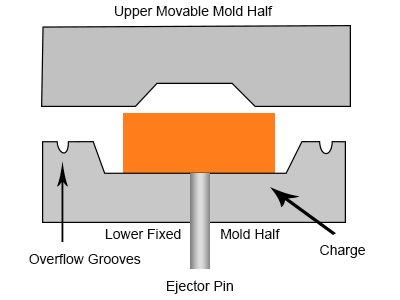What is Compression Molding?
Compression molding is the process where a heated rubber material is placed in one side of a mold, then the other side of the mold is clamped down, and the rubber material is compressed into the desired shape. The mold must also be heated, as the combined compression and heat is what causes the rubber to take its new shape. The mold also has to be designed to meet certain accommodations. For example, the mold needs to have overflow grooves built into it. Since it is difficult to accurately predict the amount of rubber material needed without any overflow, it is better to error on the safe side and use a little extra material to ensure the mold is filled and the piece is molded correctly. This means that every piece will have flash that needs to be trimmed.
Benefits of Compression Molding
One of the biggest benefits of compression molding is cost. Compared to other processes like plastic injection molding, creating a mold is a lot cheaper. (Obviously this is a comparison of a rubber manufacturing process to a plastic manufacturing process – not apples-to-apples – but it’s just for the relative comparison). When creating a mold for compression molding, you don’t have to worry about creating gates and runners. You also won’t need to complete a mold flow analysis.
Second, it is cheaper and easier to create larger parts. Generally, with other manufacturing processes, it gets significantly more expensive as part size increases. For example, with plastic injection molding, not only do you need to create a larger mold, but you also need to increase the total clamp force a machine can produce. With compression molding, you don’t need to significantly increase the pressure of the machine when you make larger parts.
The thickness of parts can vary quite a bit – you can easily produce parts that are between 1.3 mm thick to 1 inch. You are also able to get seamless design features with compression molding – you don’t have to worry about the flow lines or knit lines that may appear in injection molding.


Disadvantages of Compression Molding
One of the issues with compression molding is the long cycle times. One cycle can take up to several minutes as a technician has to manually place the material into the mold, heat it up, apply pressure and then wait for the mold to cool off enough to remove the part.
Parts require additional work after they are molded. By the very nature of compression molding, parts will have flash, so there is an additional step of removing the flash.
Another issue is that compression molding isn’t the best choice for complex designs. Simple designs can be easily filled, but complex designs can leave sections underfilled.
Compression Molding for Your Parts
At Takumi, we can help you get your parts created. If you have any questions on whether or not your part can be compression molded, just use our instant quote system to submit a quote. In about one business day we will let you know whether or not your part can be created via compression molding. We look forward to working with you.
Process for Compression Molding
Takumi’s online quoting system and mold frame sharing technology enables us to simplify and shorten both the quoting and tooling manufacturing process for plastic injection molding.
- Load your 3D CAD file to get your mold and part quote.
- Add your requirements for inserts in the comments, and your project manager will contact you.
- Upon order confirmation, Takumi starts the mold and part order process.
- Tooling design review by Takumi engineers.
- Upon design approval, Takumi begins building your injection mold.
- Customer examines samples for approval.
- Part production begins.
Compression Molding Highlights
- Fast mold and part quote (inserts must be quoted offline by a project manager)
- Low cost, high quality and fast turnaround
- Mold frame sharing technology
- Online project management
- Trouble-free part modifications
- Any commercially available material and surface finish
